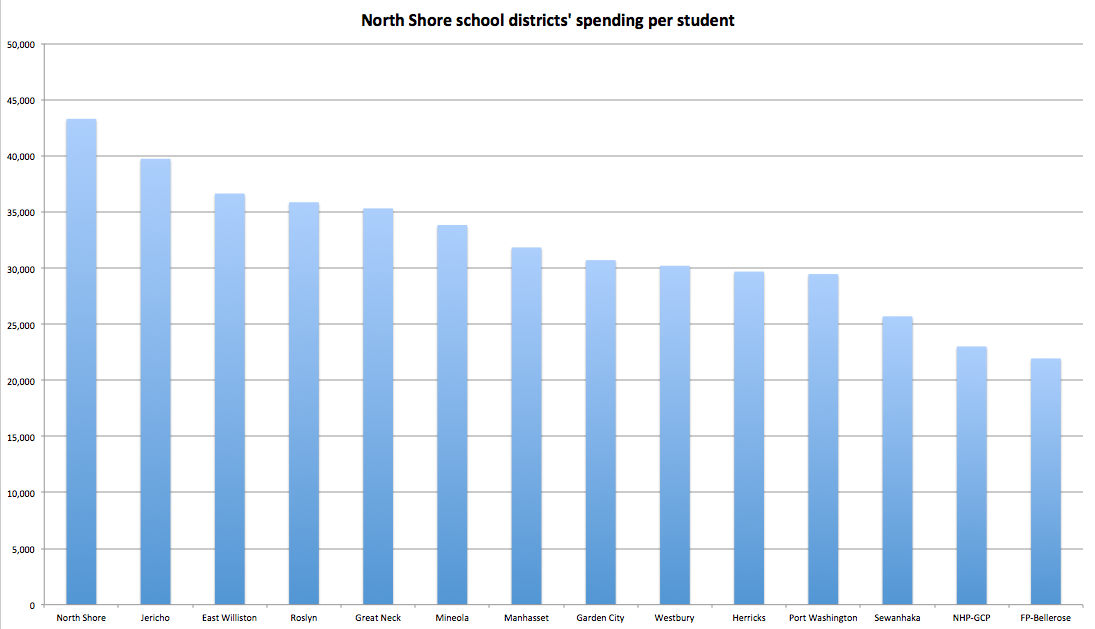Nassau County school districts that allocate the most funds per enrolled student outspend districts that provide the least amount by more than $20,000, according to a study of state statistics by Blank Slate Media.
The study analyzed the enrollment figures, demographics and budget expenditures for the 56 public school districts in Nassau County. The study did not take into account property tax values, special education programs, adult education programs, English as new or secondary language programs, or other external factors aside from the overall budget and how many students were enrolled in the district.
The average annual spending per pupil based on approved budgets and enrollment figures from New York’s Department of Education website was $32,424 throughout the county. The average number of enrolled students in each district in the county was 3,510.
The study examined approved 2019-20 budgets based on preliminary enrollment figures for 2018-19.
The Island Park school district, with two schools and 743 students, budgeted the most spending per pupil, according to state figures. The district’s budget of $40.6 million results in spending of $54,656 per student.
The Franklin Square school district had almost the same budget as Island Park, $40.16 million, but with three schools and 1,981 students, the district spent $20,274 per student, the lowest of the districts.
On the North Shore, the average number of students enrolled in each district was 3,749, with average spending of $31,943. The Floral Park-Bellerose school district allocated the least amount of funding per student, $21,944 for 1,479 students, while the North Shore school district allocated $43,295 each for 2,548 students.
The other highest-spending school districts were Jericho at $39,736 per student, East Williston with $36,638 per student, Roslyn with $35,861 per student, Great Neck with $35,312 per student and Mineola with $33,834 per student.
The eight other school districts on the North Shore all spent less per student than the $32,424 countywide average, three of which had enrollments predominantly made up of Hispanic/Latino or Asian students.
None of the school districts on the North Shore that spent more per student than the countywide average had an enrollment of Black students greater than 3.5 percent.
According to the data, a total of 32 school districts in the county spent less than the average $32,424. Of the districts that spent below the average, less than half of 15 districts’ enrollment was made up of white students. Of the 24 school districts that spent more than the $32,424 average per pupil, 20 had enrollment made up of a majority of white students.
In five school districts, Black students make up the largest group. Those districts are Malverne with 48 percent, Baldwin with 47 percent, Elmont with 45 percent, Valley Stream 30 with 38 percent, and Valley Stream Central with 29 percent. The average enrollment for all five districts was 3,139 students while the average spending per student was $29,243, according to the figures.
In 10 school districts, Hispanic or Latino students account for the largest group. Those districts are Hempstead with 79 percent, Westbury with 74 percent, Freeport with 67 percent, Glen Cove City with 62 percent, Lawrence with 61 percent, Uniondale with 60 percent, Roosevelt with 57 percent, West Hempstead with 45 percent, Valley Stream 24 with 38 percent, and Valley Stream 13 with 29 percent. The average enrollment for all the districts was 3,926 while the average spending per student was $31,087.
A total of 37 school districts’ enrollment was made up of a majority of white students. All of the school districts throughout the North Shore aside from New Hyde Park-Garden City Park, Herricks and Westbury were included in that calculation. According to the figures, the average enrollment of those districts was 3,451 students, and the average amount spent per pupil was $33,520.
Alan Singer, a professor of teaching, learning and technology at Hofstra University, discussed the disparities in education provisions throughout Long Island and proposed two potential solutions to close the gap.
Singer said one solution would make state officials responsible for funding education.
“Right now, New York state assigns local municipalities the responsibility to provide education,” Singer said. “These localities bear the main brunt of financial costs through real estate. If localities used the state income tax rather than going through real estate, the state would provide equal funding to all districts.”
Another potential solution that Singer discussed was consolidating smaller districts into regional districts that would provide a more “integrated education and equal funding” for students.
“There is no real reason why the minidistricts couldn’t be consolidated,” Singer said. “For instance, why isn’t Roosevelt part of Bellmore-Merrick? The district would still be between 60-70 percent white, and there wouldn’t be any problems with educational integration.”
Singer also touched on some of the other expenditures that schools face due to state or federal guidelines that were not taken into account in the study.
“In Hempstead schools, a lot of money is taken out to support charter schools, so Hempstead public schools actually have less money,” he said.
The population of Hempstead’s schools is dominated by Hispanic or Latino students, 78 percent, which also requires a certain amount of English as a second or new language programs to be implemented. While each school district can figure out a way to include them in its budget and curriculum, certain baseline requirements for programming are required, but not funded by, the federal government.
Singer said the disparity in education is a “political issue,” with real estate interests and families providing the resistance to modifying the current funding system.
“This political issue is not a Democratic or Republican matter,” he said. “Most local officials are afraid to present these drastic changes because they may be voted out of office. If you look at real estate ads, the first thing the advertisement will most likely say is how the local school district is. School districts are not supposed to be the basis here.”



